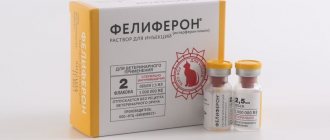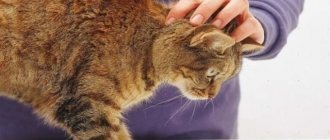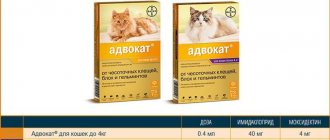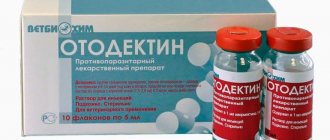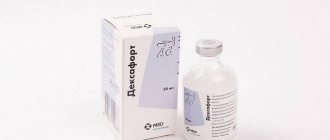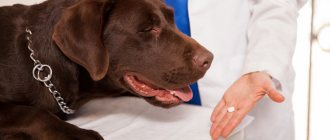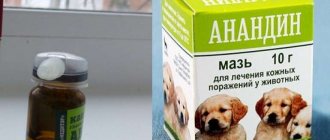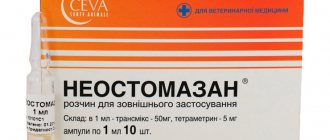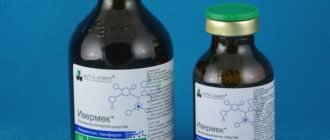Home » Useful Information
Cats, like people, can experience pathologies of the musculoskeletal system, which are often accompanied by fever and pain. In this case, the drug Flexoprofen comes to the rescue, which quickly relieves a number of unpleasant symptoms. The medicine has contraindications and may contribute to the occurrence of adverse reactions, so it is recommended that you read the instructions before starting therapy.
- 2 When is the medication prescribed?
- 3 How to use the solution correctly
3.1 How to give a hypodermic injection to a cat - video
- 3.2 Special instructions and precautions
- 5.1 Medicines with similar effects - photo gallery
Composition and release form
The anti-inflammatory drug is available in the form of an injection solution. The transparent liquid may be colorless or have a light yellow tint. For packaging, bottles made of clear or dark glass are used. Pharmacies offer bottles of various sizes, but for cats it is worth buying small bottles of 5 or 10 m, since the dose is calculated taking into account the weight of the animal.
The main active ingredient is ketoprofen. Its concentration in the medicinal solution can be 2.5%, 5% and 10%. The composition also includes the following components:
- water for injections;
- benzyl alcohol;
- lemon acid.
They perform an auxiliary function, for example, citric acid improves the absorption of ketoprofen.
There are no special requirements for storing the medication, although the bottle should be in a dry place protected from ultraviolet rays. The temperature should be between 5 and 25 degrees Celsius.
Note! When storing the drug at low temperatures (about 5 degrees), crystals may appear at the bottom, which dissolve on their own when the liquid is heated. This phenomenon does not affect the properties of the drug in any way.
Dosage of the drug
In this case, the average is 2 ml of the composition as an intramuscular injection. The only thing is that for adult pets of medium and large breeds, in preparation for surgery, the dosage increases to 3 ml, and for puppies, on the contrary, it decreases to 1 ml. Also, for dogs up to 6 months of any breed, only 1 ml will be sufficient for the treatment of colitis.
The course of treatment in the vast majority of cases is limited to a single injection. However, in some cases it is necessary to pierce the animal within 3 or even 5 days.
How it works
Flexoprofen has the following properties:
- eliminates pain;
- relieves inflammation;
- reduces swelling;
- has an antipyretic effect.
The effect of the drug is determined by ketoprofen. The principle of its action is that when it enters the body, the active component blocks the production of substances that are involved in inflammatory processes, accompanied by pain, swelling, and redness.
The advantage of Flexoprofen is its rapid action. Just 30 minutes after injection, the concentration of ketoprofen in the blood reaches its maximum value. Since the drug is distributed throughout the body along with the bloodstream, it works effectively regardless of the location of pain. The animal body absorbs from 85 to 100% of the drug. The components of the drug are excreted from the body mostly through the kidneys.
Description of the medicine
This hormonal anti-inflammatory drug belongs to the group of glucocorticosteroids. Its main active ingredient is an analogue of the hormone cortisol - dexamethasone in the form of sodium phosphate and phenylpropionate. In addition, it contains various auxiliary components: sodium chloride and citrate, benzyl alcohol, hydrochloric acid and others. The medicine is a white suspension intended for injection. "Dexafort" is produced in 50 ml bottles. The drug is quite expensive - from 700 to 1000 rubles, and for pets a dose of no more than 2 ml is needed.
Indications for use
The drug is effectively used in the treatment of chronic and acute pathologies. Indications for the use of Flexoprofen for cats according to the instructions are:
- arthritis, arthrosis and other diseases of the musculoskeletal system;
- fractures, dislocations and other injuries;
- acute colic;
- pathologies that are accompanied by an increase in body temperature.
Also, the medicine is often prescribed in the postoperative period to reduce pain and prevent swelling.
Note! The medicine is used to eliminate unpleasant symptoms (pain, swelling, increased body temperature), but it is not able to cope with the cause of the disease, so it is used only in complex therapy.
Table of drugs similar in effect
| Name | Release form | Active ingredient | Indications | Contraindications | Adverse reactions | Can it be used to treat pregnant and lactating cats? | Price |
| Vetalgin | Pills |
| Inflammatory and infectious diseases, as well as spasms of smooth muscles. |
| Allergic reactions. | No. | From 134 rub. |
| Diclofenac |
| diclofenac sodium |
|
|
| No. | From 100 rub. |
| Ketoprofen |
| ketoprofen |
|
|
| No. | From 140 rub. |
How to use
Typically, Flexoprofen is administered to cats intramuscularly or subcutaneously. For acute pain or extreme fever, it is recommended to give intravenous injections so that the medicine begins to work faster.
The dose is calculated based on the pet's weight, so you need to weigh it first. For every kilogram of weight you need 2 mg of the active substance. The amount of solution depends on its concentration. Typically 2.5% Flexoprofen is used for cats. 1 ml of this solution contains 25 mg of ketoprofen, that is, it is designed for 12.5 kg. To avoid overdose, entrust the calculation of the dose for your cat to your veterinarian.
Injections should be given once a day. The course of treatment can last from 1 to 5 days. It is not recommended to use the medicine for more than 5 days due to the risk of side effects. You should avoid missing the next injection, as this may affect the effectiveness of the drug. If the injection could not be given on time for some reason, you need to return to treatment as soon as possible. There is no need to increase the dose.
Analogues of the drug
There are several analogues of Flexoprofen with a similar composition and effect:
| Analogue | Differences | average price |
| Ainil 1% | Designed specifically for dogs and cats. Contains the same active ingredients as Flexoprofen: ketoprofen and arginine. The method of use, indications and contraindications are the same. | 1,200 rub. for 50 ml |
| Ketoquin 1% | Also completely analogous. But it can cause more serious negative reactions: vomiting blood, black stools, convulsions, respiratory depression. | 325 rub. for 10 ml |
| Ketofen | Contains only one active ingredient - ketoprofen. Available in two forms: solution (1%) and tablets (5, 10 and 20 mg). | Solution 20 ml - 1,400 rubles; tablets: 5 mg - 580 rubles, 10 mg - 675 rubles, 20 mg - 1,130 rubles. |
Important points
When using Flexoprofen to treat cats, the following should be considered:
- The anesthetic should not be combined with the use of other non-steroidal anti-inflammatory drugs to avoid overdose.
- It is not recommended to use the medicine together with anticoagulants (drugs that thin the blood), glucocorticoids and laxatives.
- Do not mix an anti-inflammatory drug with other medications in the same syringe.
- When administering a medicinal solution, you must follow the rules of antiseptics. For injections, use disposable syringes or sterile needles that have been boiled for 15 minutes.
Flexoprofen can have a negative effect on the digestive system and cause bleeding, so its use is often combined with Ranitidine or other similar medications.
When working with the drug, you need to follow simple safety precautions. After the procedure, wash your hands with soap and running water. Medicine bottles must be disposed of; using them for domestic purposes is strictly prohibited. If you are hypersensitive, you should use rubber or latex gloves to avoid direct contact with the solution, which can cause a rash or other allergic reactions.
Flexoprofen
FLEXOPROFEN for the treatment of inflammatory diseases of the musculoskeletal system and as an analgesic and antipyretic agent in dogs, cats, racing horses and calves
(organization-, Republic of Belarus)
I. GENERAL INFORMATION
Flexoprofen 2.5%, 5% and 10% (Flexoprofen 2.5%, 5%, 10%) is a non-steroidal anti-inflammatory drug in the form of an injection solution used for the treatment of inflammatory diseases of the musculoskeletal system and as an analgesic and antipyretic products for dogs, cats, sports horses and calves and containing in 1 ml 25, 50 and 100 mg of ketoprofen as an active substance, respectively, and L-arginine, benzyl alcohol, citric acid and water for injection as excipients.
Flexoprofen is a colorless or slightly yellow transparent solution.
Flexoprofen 2.5%, 5% and 10% are packaged in 5, 10, 20, 30, 50, 100, 200 and 250 ml in dark glass bottles of appropriate capacity. Each bottle is labeled in Russian indicating: the manufacturing organization, its address and trademark, the name of the drug, the name and content of the active substance, the amount of the drug in the bottle, the batch number (containing the date of manufacture), the expiration date, storage conditions, the inscriptions “ Sterile”, “For injection”, “For animals” and provide instructions for use
Flexoprofen is stored with caution (list B) in a dry place, protected from direct sunlight at a temperature of 5 C to 25 C. Shelf life under storage conditions is 3 years from the date of manufacture
Flexoprofen should not be used after the expiration date.
II. PHARMACOLOGICAL PROPERTIES
Ketoprofen, which is part of Flexoprofen, has anti-inflammatory, analgesic and antipyretic effects, and is effective for the treatment of acute, subacute and chronic inflammation, accompanied by the symptom of pain. The mechanism of action of ketoprofen is to suppress the synthesis of prostaglandins by disrupting the metabolism of arachidonic acid. With intramuscular administration of the drug, the maximum concentration of ketoprofen in the blood plasma is observed after 30 minutes. The bioavailability of ketoprofen, depending on the type of animal, varies from 85% to 100%. Ketoprofen is excreted from the body primarily through the kidneys.
In terms of the degree of impact on the body, according to GOST 12.1.007-76, Flexoprofen belongs to hazard class 4 (low-hazard substances); in recommended doses does not have a sensitizing effect in the body.
III. ORDER OF APPLICATION
Flexoprofen is used to treat inflammatory diseases of the musculoskeletal system (arthritis, arthrosis, dislocations, edema, herniated discs, synovitis, tenosynovitis, etc.), pain syndrome of various etiologies (traumatic and postoperative pain, colic), as well as hyperthermia in dogs, cats, sport horses and calves.
Directions for use and dosage:
Dogs, cats: subcutaneously, intramuscularly, intravenously at a dose of 2 mg/kg of animal weight (according to ketoprofen), 1 time per day, for 1-5 days.
Sports horses: intravenously at a dose of 2.2 mg/kg of animal weight (according to ketoprofen), 1 time per day, for 1-5 days.
Calves: intravenously or intramuscularly at a dose of 3 mg/kg of animal weight (according to ketoprofen), 1 time per day, for 1-5 days.
In recommended doses, Flexoprofen does not cause complications in animals.
Contraindications to the use of Flexoprofen are allergies to ketoprofen and other components of the drug, stomach and duodenal ulcers, hemorrhagic syndrome, severe liver and kidney failure, pregnancy. Flexoprofen is not recommended for use in combination with other non-steroidal anti-inflammatory drugs, glucocorticoids, anticoagulants and diuretics. Do not mix with other medications in the same syringe.
Slaughter of calves for meat is permitted no earlier than 5 days after the last use of the drug. The meat of forcedly killed animals before the expiration of the specified period can be used as feed for fur-bearing animals or for the production of meat and bone meal.
IV. PERSONAL PREVENTION MEASURES
When working with Flexoprofen 2.5%, 5% and 10%, you should follow the general rules of personal hygiene and safety precautions provided for when working with medicines.
Containers containing the drug are prohibited from being used for household purposes.
Flexoprofen should be stored out of the reach of children. Registration number PVI-2-1.8/02383
www.vetlek.ru
When not to use
According to the instructions, Flexoprofen for cats cannot be used in the following cases:
- when bearing offspring (regardless of the period);
- with liver failure;
- with renal failure;
- for problems with blood clotting;
- with bleeding;
- with stomach or duodenal ulcers.
You should also avoid using the drug if you are intolerant to the active substance or other components. For chronic pathologies of the liver and kidneys, it is necessary to consult a doctor before use. In this case, it is recommended to constantly monitor the performance of these organs.
The anesthetic is usually well tolerated by animals and does not cause side effects. In case of intolerance to the components, allergic reactions occur. In this case, further treatment with an anti-inflammatory drug is stopped and anti-allergy medications and drugs are prescribed to relieve the symptoms that appear.
In case of overdose, the following side effects may occur:
- nausea;
- vomit;
- stomach upset;
- loss of appetite;
- refusal of food;
- weakness.
If such symptoms appear, stop taking Flexoprofen. If the animal's condition does not improve, you should consult a doctor.
Pharmacological properties of the drug
The active component of the drug, as we have already mentioned, is ketaprofen. It has the following properties:
- Antipyretic.
- Anti-inflammatory.
- Painkiller.
According to the instructions and reviews of Flexoprofen for cats, the drug is successfully used to treat a whole range of inflammations - acute, chronic, subacute, accompanied by pain. The mechanism of action of ketaprofen is as follows: the substance disrupts metabolic processes with arachidonic acid, which in turn suppresses the formation of prostaglandins.
With intramuscular administration of the drug, its highest concentration in the blood plasma is noticeable within half an hour. Bioavailability for the body: 85-100% (depending on the type of animal). The medicine is excreted through the kidneys.
The instructions for Flexoprofen for cats indicate that the product is close to low-hazard (class 4 according to GOST 12.1.007-76). If the recommended dosage is followed, it does not have a sensitizing effect on the patient’s body.
Owner reviews
Victoria, owner of a British cat:
“When our cat caught the infection (she had feline distemper), she developed a very high temperature. To relieve fever, the doctor prescribed Flexoprofen. One injection was enough for the temperature to return to normal and not rise again. There were no side effects, Muska tolerated the medicine well.”
Vadim, owner of a 10-year-old cat:
“Older animals often have joint problems. They didn't spare our 10-year-old cat either. Arthritis was accompanied by severe pain. The joints were swollen. The cat refused to even walk around the house. On the advice of a doctor, Flexoprofen injections were used to eliminate these symptoms. A week later, the cat began to run again, and the pain stopped bothering him. It’s a good medicine, but after a while the symptoms return, so we repeat the course every 2-3 months.”
Svetlana, owner of a Persian cat:
“When we treated our cat for uveitis, Flexoprofen was also included in the complex therapy. The drug saved the animal from suffering. Even after stopping treatment, the pain did not return. It’s a good drug, but you shouldn’t use it for self-medication because of the risk of aggravating health problems.”
Flexoprofen 10
Flexoprofen 10% - (ketoprofen) treatment of inflammatory diseases of the musculoskeletal system (arthritis, arthrosis, dislocations, edema, synovitis, tenosynovitis, etc.), pain syndrome of various etiologies. Indications for use Treatment of inflammatory diseases of the musculoskeletal system (arthritis, arthrosis, dislocations, edema, synovitis, tenosynovitis, etc.), pain syndrome of various etiologies (traumatic and postoperative pain, colic), as well as hyperthermia in cattle, pigs, horses, dogs and cats. Advantages • high stability and security; • shelf life is 1.5 times higher than analogues; • maximum concentration in blood plasma is achieved after 30 minutes; • the possibility of using the antibacterial drug TIOCEFUR as a solvent. Composition and release form FLEXOPROFEN 10% injection solution contains 100 mg of ketoprofen as an active ingredient in 1 ml. FLEXOPROFEN 10% is produced in the form of a sterile, transparent, colorless or slightly yellowish solution in glass or plastic bottles of 1; 2; 5; 10; 20; thirty; 50; 100; 200; 250; 500 and 1000 ml. Pharmacological properties Ketoprofen, which is part of FLEXOPROFEN, has anti-inflammatory, analgesic and antipyretic effects, is effective for the treatment of acute, subacute and chronic inflammation, accompanied by the symptom of pain. The mechanism of action of the drug is to suppress the synthesis of prostaglandins by disrupting the metabolism of arachidonic acid. When administered intramuscularly, the maximum concentration of ketoprofen in the blood plasma is observed after 30 minutes. The bioavailability of the drug varies from 85% to 100%. Ketoprofen is excreted from the body primarily through the kidneys. In recommended doses, the drug does not have a sensitizing effect and does not accumulate in the body. Dosage regimen • cattle: intravenously or intramuscularly at a dose of 3 mg/kg of animal weight (according to ketoprofen), 1 time per day, for 1-5 days; • pigs: intramuscularly at a dose of 3 mg/kg of animal weight (according to ketoprofen), 1 time per day for 1-3 days; • horses: intravenously at a dose of 2.2 mg/kg of animal weight (according to ketoprofen), 1 time per day, for 1-5 days; • dogs, cats: subcutaneously, intramuscularly, intravenously at a dose of 2 mg/kg of animal weight (according to ketoprofen), 1 time per day, for 1-5 days. Contraindications Contraindications to the use of Flexoprofen are individual hypersensitivity to ketoprofen and other components of the drug, stomach and duodenal ulcers, hemorrhagic syndrome, severe liver and kidney failure, pregnancy. Special instructions FLEXOPROFEN is not recommended for use in combination with other non-steroidal anti-inflammatory drugs, glucocortioids and anticoagulants. Do not mix with other medications in the same syringe. Slaughter of animals for meat is permitted no earlier than 5 days after the last use of the drug. Meat of forcedly killed animals before the expiration of the specified period can be used for animal feeding or for the production of meat and bone meal
Conditions and periods of storage Store FLEXOPROFEN with precautions (list B) in a dry place, protected from light, at a temperature not exceeding 25 ° C. Shelf life, subject to storage conditions, is 3 years from the date of manufacture.
Answers to frequently asked questions
Have crystals appeared in the solution? Is the medicine spoiled?
No, this is normal. Occurs when the drug is stored in the refrigerator, at a temperature of about 5°C. The crystals do not affect the quality of the drug and will disappear if the solution is warmed.
Can Flexoprofen be given to pregnant dogs?
The instructions prohibit giving injections to pregnant and lactating bitches due to the risk to puppies. But in conditions that threaten the dog’s life, the solution is administered under the supervision of a veterinarian.
Is the medication suitable for all breeds?
It has been noted that side effects develop more often in small dogs. The following breeds are more prone to them: Chihuahua, Bichon Frize, Pekingese, Toy Terrier.
The dog vomited after the injection. Is it worth continuing to give the drug?
If any negative reactions occur, NSAIDs are discontinued. But each case is individual: consult your veterinarian. It is possible that gastro- and hepatoprotectors will be additionally prescribed.
